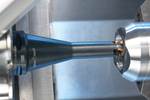How to Get the Most Out of Carbide Recycling
By choosing the right recycling program, mold manufacturers can help sustain both the environment and their industry.
Recycling is part of our everyday lives. At home, recycling is done almost exclusively as our way of protecting the environment. At work—especially with in a manufacturing company—the concept of recycling goes far beyond the curb-side service done at home. By choosing the right recycling program, mold manufacturers can help sustain both the environment and their industry.
There are many common concerns that shops share when it comes to recycling: What needs to be recycled? How should materials be collected? What are the costs of collection and transportation? What is the most environmentally responsible method of disposal or recycling?
Today you have many options when it comes to responsible waste removal. Many have contracted rates with local scrap dealers for material pickup and removal. This may seem good enough, but it doesn’t consider any factors beyond price and convenience.
Carbide inserts, solid carbide end mills and solid carbide drills used in metal cutting are good examples of products with more factors to consider when partnering with a recycler. Beyond price and convenience, shops need to also consider industry impact and then select an industry-sensitive recycling program.
To get the most out of carbide recycling, start by looking for a partner rather than a vendor. One that has your company’s success in focus. A mutual interest in the business and industry should go beyond the simple exchange of used carbide and cash.
Environmentally sensitive recycling means that the recycler buys and collects the used carbide and breaks the carbide down to its basic elements. The process takes place at ISO-certified facilities using environmentally sensitive processes. This protects the environment, but also protects the customer and industry with proper waste disposal using approved environmental controls and processes. Scrap dealers likely won’t even know where or how their scrap carbide is ultimately processed.
Industry-sensitive recycling may be a new term for many. What this means is that the recycler looks to support customers through the reuse of recycled carbide materials in the cutting tools they will purchase in the future. The world’s natural supply of tungsten, one of the basic elements of carbide, is quite limited, yet used in a wide variety of products and industries. Using these recycling programs ensures that used carbide will be recycled back into the industry products that are used daily, keeping prices and supply in control for the industry. Scrap dealers cannot ensure the used carbide they buy will ultimately be reinvested into the metal cutting industry.
Getting a fair price for used carbide is an important consideration for any manufacturer. However, the price is just one dimension of a much more complex decision regarding carbide recycling. Consider the environment, how the used carbide is reprocessed and the products in which it will ultimately be reused. When selecting who to sell used carbide to, companies should give consideration to all aspects to ensure the decision supports their bottom line, the environment and the metal cutting industry.
Related Content
-
Internal and External Factors Continue to Impact U.S. Moldmaking
Sustainable growth remains in the forecast as economic conditions continue to progress.
-
VIDEO: Why Is Sustainability Important to Mold Builders
Marta Orozco with DME shares ways mold builders can be a part of building a more sustainable future.
-
Innovative Mold Building Enhances Packaging Material Efficiency, Elevates Recyclable Design
A manufacturing-focused design and optimized tooling enhance material efficiency in packaging for a new medical instrument.












.png;maxWidth=300;quality=90)


